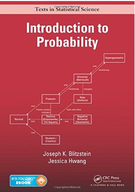Show that if P(A) = 1, then P(A
Chapter 2, Problem 18(choose chapter or problem)
Show that if P(A) = 1, then P(A|B) = 1 for any B with P(B) > 0. Intuitively, this says that if someone dogmatically believes something with absolute certainty, then no amount of evidence will change their mind. The principle of avoiding assigning probabilities of 0 or 1 to any event (except for mathematical certainties) was named Cromwells rule by the statistician Dennis Lindley, due to Cromwell saying to the Church of Scotland, think it possible you may be mistaken. Hint: Write P(B) = P(B \ A) + P(B \ Ac), and then show that P(B \ Ac) = 0
Unfortunately, we don't have that question answered yet. But you can get it answered in just 5 hours by Logging in or Becoming a subscriber.
Becoming a subscriber
Or look for another answer
